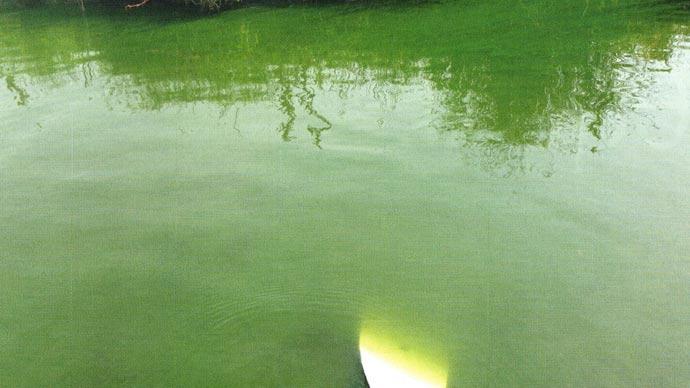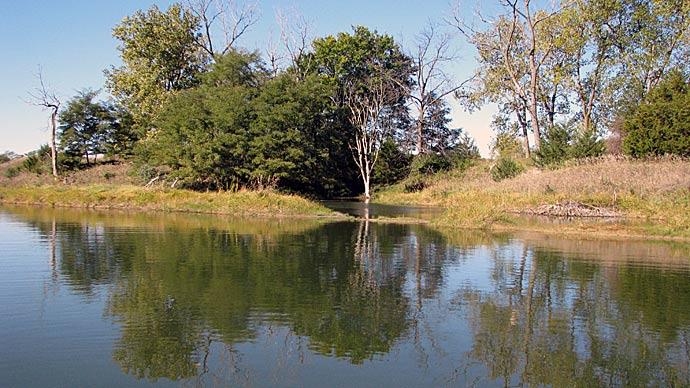
Kids love chocolate milk. They believe it contains all seven food groups. Creamy, smooth, rich and full, tasty. Delightful for a child to drink.
But don't try to have fish in. chocolate milk.
I spent way too much time this spring watching The Weather Channel, (the grownup version of MTV), and praying for rain. Instead of a fair share of the wet stuff, our area of the country was blessed with wind, more wind and then some gale force wind. Other parts of the country, I noticed, had a similar experience except in the form of rain, more rain and big rain.
When it comes to heavy wind or heavy rain, both can produce problems when too much of those good things cross paths with thick clay dirt. One of the negatives is turbidity, a measure of visibility in water. Wind and wave action or excess rain can roil your pond, creating muddy or cloudy water. That is exactly what happened to me this spring.
Esthetically unappealing, my chocolate milk-looking pond water gave me a sense the fish tasted kind of muddy. Besides, the productive plankton and fish nourishing algae blooms I had experienced in past springs weren't occurring.
So off to the Internet. I went to research, followed by a phone call to the Pond Boss staff for confirmation. Soon I was armed with information necessary to tackle the problem. Exactly what was the problem? I decided there were three problems to solve. Problem one was, '"What was causing the turbidity?" Number two was. ''What to use to make the muddiness go away, and how much material should I put in the pond to get rid of suspended soils?" Three was. "How to apply the proper material effectively?"
Next, I chased down three one gallon glass pickle jars. After thoroughly cleaning the jars with fresh water, 1 went to the pond and filled them up with my murky chocolaty water. One jar stood alone and I watched it for about a minute. Immediately I could detect muddiness was caused by particles moving and floating in the entire water column. This is known as ''suspension." I had read suspended soil was caused by a missing negative or positive electrical charge in the water. The soil particles have the opposite charge so they attract and suspend. For you scientists this is known as "colloidal suspension," for me, it means mud in my pond.
The other two jars received a tablespoon of powdered gypsum. I stirred it to dissolve, and added 2 tablespoons to the other jar and mixed well. During research, I learned that gypsum and aluminum sulfate could reverse the charge and cause the particles to collect and drop to the bottom, thereby clearing the pond. However, gypsum has no side effects and alum can have devastating side effects, (it can dramatically lower pH), so I chose to start with the safest stuff.
After about 5 minutes the particles in the jars began to stick together like tiny wet magnets, and settled to the bottom. To all you scientists, that's called "flocculation." To me, it means clear water.
Eureka! Mud in the jar was settling, water was clearing, problem one solved. As I scratched my head and pondered problem two, I tried to figure out how one tablespoon of gypsum in one gallon of water translates to a 10 acre lake? Well this is one for the math wizards, or a phone call to the Pond Boss staff, or the Wyman method, by figuring out the maximum depth and multiply it by 40 percent to calculate my average depth. Then figure about 100 pounds of gypsum for every 3 feet of depth.
That's where common sense begins to take over. If that calculation doesn't work then after about 3 days add more gypsum. Or, if you have a gram scale, weigh a teaspoon of gypsum, compare the percentage to the weight of a gallon of your water, and extrapolate.
Problem three was how to get the gypsum in the lake and get it stirred into solution. I thought about a lot of different ways but the most practical, for me, seemed to be with the trolling motor of a boat. I loaded gypsum into the boat, 150 pounds at a time, and began the process of mixing it with the prop wash of my motor, and tossing it with a scoop into the water, for the best coverage possible. I learned a fun lesson. Tossing the stuff with the wind works great, but gypsum can be flour dust fine grade, and when you try to toss it into the wind, prepare to look like Casper the friendly ghost when you're done. The stuff spreads like a cloud.
It took about 4 hours to broadcast the allotted amount and I noticed the water was already getting clearer within six hours. By the next day it was 50 percent improved.
I don't know how long clear water will last or if heavy winds will churn the water back up and muddy the scene again, but gypsum is cheap. Sooner or later it will have to quit blowing so hard, so I will stay at it. But then when it does quit blowing it probably won't quit raining.
One thing about pond management, you never run out of things to do!
Think I'll get out of this heat, go back in the house, turn on the weather channel and drink a frosty glass of chocolate milk.
Besides, it's smart fisheries management.
Reprinted with permission from Pond Boss Magazine



